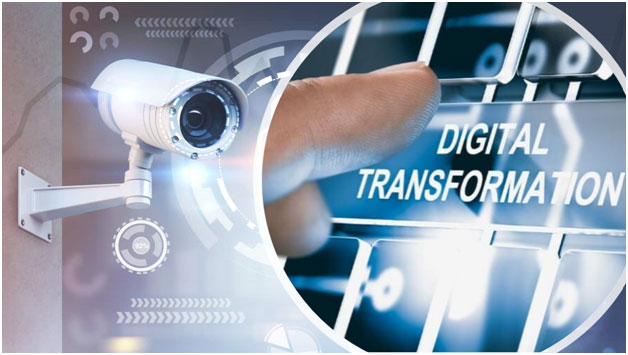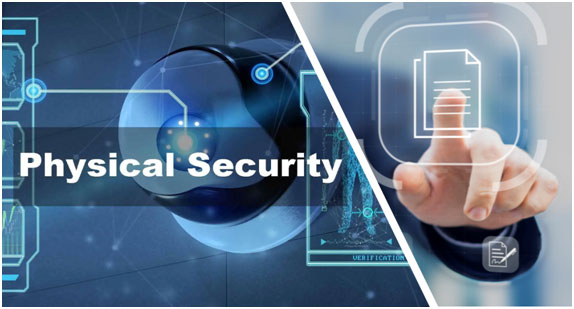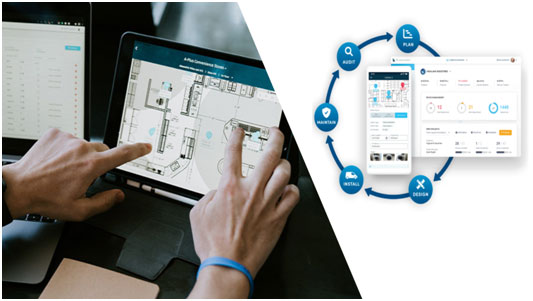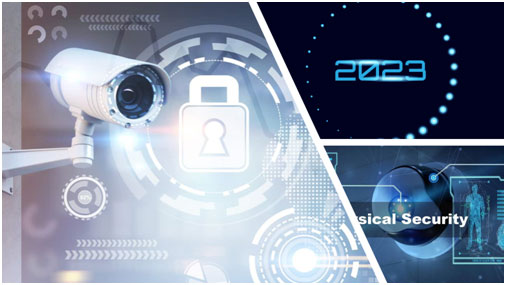Top digitization challenges, opportunities, and physical security trends for 2023.
Topics Covered
-
Digitization challenges for physical security teams.Digitization challenges for physical security teams.
-
New physical security digitization opportunities for enterprise users.New physical security digitization opportunities for enterprise users.
-
Physical security digitization trends for 2023.Physical security digitization trends for 2023.
-
Physical Security Lifecycle Management.Physical Security Lifecycle Management.

For many industries, including security, digitization was a top priority in 2022, and the numbers prove it. Spending on digital transformation surpassed $1.3 trillion worldwide, and 91% of enterprises currently have a digital-first business strategy or plan to adopt one. Despite organizational and economic challenges, digital transformation remains top of mind for many. Moreover, 2023 will be a transformative year for organizations that embrace digitization.
Digitization refers to the act of making analog information digital. While some industries have fully embraced digitization (e.g., more than 95% of property buyers use digital resources to guide their decisions), the physical security industry faces the challenge of overwhelming scale without the technology to support them.
In this article, we’ll share the top challenges, opportunities, and trends to consider when it comes to digitally transforming the delivery and management of your security infrastructure in 2023 and beyond.

Security teams can benefit significantly by adopting a digitization strategy, industry complexities and a lack of tools to manage security devices digitally have hindered the transformation.
In an interconnected world, enterprises require many physical security devices and sensors to operate a robust physical security program safely and efficiently. As a security director or operator, you’re constantly reviewing your organization’s vulnerability and strengths across a range of topics, including :
- Risk tolerance–the level of risk that is acceptable to your organization.
- Planning – Protective security measures that address operational risks.
- Maintenance– Systems and tools to isolate problems, generate tickets, and keep your system running with minimal downtime.
- Compliance –Ensuring physical security measures are compliant with relevant regulations.
With so much to consider, it’s no wonder that in a Microsoft-Accenture Survey, 89% of security leaders stated that while digitization was important, only 30% deemed it urgent. But with all the indicators pointing to an ever more digital world, security leaders will have to embrace digitization to thrive in 2023 and beyond.
Digitization challenges for physical security

The challenge for most enterprises is that they tend to focus on cyber risks and adopt a more reactive approach when it comes to physical security. But with the acceleration of technology combined with the acceleration of cyber-physical convergence, a reactive approach to physical security is not an option.
In today’s digital world, an enterprise requires many physical security devices and sensors, including surveillance cameras, alarm systems, sensors, access control systems, security lighting, etc. Additionally, these devices are often sourced from separate manufacturers and sometimes deployed across multiple buildings and time zones.
Once the devices are installed, the security team is fully responsible for managing these devices, often using legacy tools designed for the physical world. In addition, the team must monitor and control the numerous upgrades, adjustments, and other lifecycle issues that arise over time. The amount of manual labor is staggering for even the most efficient security department.
Leading digitization challenges

Digitizing your physical security systems requires a coordinated effort across teams. Leading challenges to widespread digitization adoption include a lack of a digital transformation strategy, organizational resistance, budget constraints, and issues specific to the security industry, such as a lack of standardized security system management practices.
Understanding the challenges and barriers other organizations commonly face when adopting digital transformation will help you identify what is slowing down your organization and how to avoid stagnating in the future. Three leading digitization challenges that will slow your organization’s digital transformation include:
Siloed decision-making
The rapid transformation in the security landscape has exacerbated the challenges that still burden large organizations with siloed departments, functions, and applications. In addition, advanced AI and machine learning capabilities – have led to even greater complexity and more fragmentation of data sources and applications.
| Challenge… | Solution |
|---|---|
| Incomplete and/or inaccurate system information. | Data-driven decision-making with consolidated system reporting. |
Economic and supply chain challenges
Without a plan, efforts to digitize your physical security systems and operations can lead to unbounded investment costs. This is especially true when considering unpredictable variables such as supply chain disruptions and inflation. Data shows that enterprise leaders anticipate more financial challenges, with seventy-five percent expecting economic and supply chain challenges to last well into 2023.
| Challenge… | Solution… |
|---|---|
| Inability to accurately forecast and plan budgets. | System performance visibility enables fiscally responsible security investments. |
Culture- mindset challenges…
A huge challenge of digital transformation is a cultural one. Everyone – from leadership to new employees – must be on the same page. Building a culture that prioritizes physical security requires accurate information to monitor ongoing service issues and stay on top of ongoing system deployments and maintenance work in real-time.
| Challenge… | Solution… |
|---|---|
| Lack of standardized security system management practices | Consistent and scalable security system practices, standardized across vendors |
Digitally transform the delivery and management of your security infrastructure
Digitization opportunities in physical security.
As a security leader, digital transformation provides an excellent opportunity to reimagine how you manage your physical security systems with new digital processes and tools. Resisting the digital trend or adopting a business-as-usual attitude will only increase risks and prevent your company from capitalizing on valuable digitization opportunities, including:
- faster access to information
- increased productivity
- lower operational costs
- improved decision-making
- automation of processes
- agility, and disaster recovery
The future is here, and thanks to cloud computing and lifecycle management platforms that enable you to manage all your system devices, you can now create value across the organization beyond traditional risk management.
By embracing digitization and reimagining how you manage your physical security systems, you’ll be able to take advantage of many digital opportunities, including:
Data-driven decision making
The world is more data-driven than ever! To improve results and streamline operations, organizations are investing in automation and prioritizing ways to foster connectivity between internal and external systems. This requires real-time data processing from across the enterprise to make informed and scalable decisions.
Scalable security system practices
Security leaders need scalable solutions to manage the many physical security devices and sensors such as surveillance cameras, access controls, and alarm systems throughout the organization.
Upgrading legacy systems
Legacy system modernization is a vital part of your overall business digitization. In an industry dominated by legacy technology, digitization allows you to upgrade your legacy systems and standardized security system management practices.
Reduce Total Cost Of Ownership
Digitization presents new opportunities for standardization and optimization of your security inventory and infrastructure. Also, it provides sustainable ways to lower maintenance costs, reduce unplanned downtime or anticipate lifecycle management issues.
Physical security digitization trends

Since 2020, we’ve seen a digitization boom driven by cloud computing and a demand for agile systems. Although we’ve seen radical changes in digitization within the past years, there’s still so much more to come.
Today’s digital transformation means limitless opportunities for those who can digitize their physical security systems. Here are just a few of the many trends that will continue to drive digitization.
Cyber-Physical security convergence
With the rapid evolution of technology physical and cyber security are linked more than ever. In 2023, the cyber-physical convergence will only accelerate as organizations seek to eliminate the silos that are currently preventing these two indispensable departments from being on the same page.
Cloud adoption acceleration
Cloud adoption among enterprise organizations is already over 94%. By 2023, 31% of organizations expect to run 75% of their workloads in the cloud. Some 27% of them plan to run at least 50% of their business processes in the cloud by then.
AI-enabled video analytics
AI-enabled video analytics offer significant value to enterprises and in 2023 we’ll see even more video surveillance innovation, including the ability to analyze data and draw out insights far more quickly than would ever be possible manually, and high-resolution cameras that can observe and analyze a wider-than-ever field of view.
Lifecycle management
Build and Manage Security Systems with Confidence
It’s estimated that by By 2023, 90% of global businesses will have contract lifecycle management solutions implemented. Lifecycle management platforms enable security professionals to manage their system planning, design, installation, and service from one centralized location while providing system-wide visibility. Often, these platforms also have reporting capabilities that help security professionals to plan security investments.
SiteOwl is the security industry’s first unified, cloud-based digital platform that offers a full lifecycle management solution that helps security professionals design, install, and manage security systems in a digital environment.
With SiteOwl, you can manage the information behind every element of your access control, video surveillance, and intrusion detection systems — all from a single location.
Digitally transform your security infrastructure
The time has come for the physical security industry to embrace digital transformation. By 2025, three out of every four business leaders will leverage digital platforms to adapt to new markets and industries. Taking essential steps today will ensure security teams can predict and mitigate threats before they occur, freeing up resources to focus on strategic action and decisions.
By leveraging technology to generate greater intelligence, physical security will also be able to do more with less, improving operational efficiency and reducing expenses by 30-50%.
Lifecycle management is a top priority for security leaders that want to digitize their physical security systems. SiteOwl is leading the digital transformation in the physical security industry by helping organizations harness the power of your systems data, enabling you to capture actionable information and insights into a centralize platform to deliver alerts when necessary, and operate safely.
Request a demo today!







